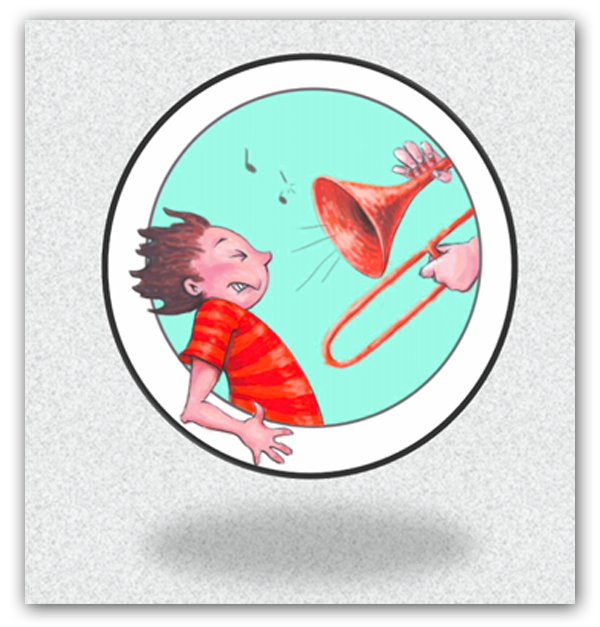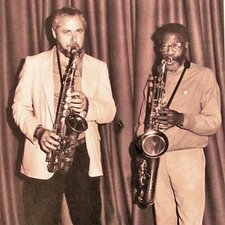Joe Henderson's
"Black Narcissus" - The Last Eight

Originally recorded on May 29, 1969 and released as part of Henderson's album "Power to the People" (which included Herbie Hancock, Ron Carter and Jack De Johnette) on the Milestone label, Joe recorded it several times subsequently. That includes the 1974 version, recorded in Paris and featured on the album of the same name.
It has since been covered by many by other artists.
Although completely different in emotional intent, scope and style, "Black Narcissus" has striking similarities in compositional structure, as well as harmonic usage, to another one of Henderson's classics, and the subject of an earlier post; namely, "Inner Urge".
I had heard different versions of "Black Narcissus" for years before actually trying to learn it myself. At that point, I realized that this simple sounding tune necessitated some closer scrutiny; especially after hearing many improvisers trying to "ramrod" their way through the last eight measure, "B" section of the tune.
In checking out the lead sheets below, we find that each tune has a 16 bar "A" section of slow moving, modal type harmony. In the case of "Black Narcissus", that means alternating adjacent diatonic m7th chords over a pedal bass for 8 bars, then repeating that scheme down a whole step for another eight.
"Inner Urge" employs the use of four 4 bar phrases for it's 16 bar "A" section; starting with an F# min7b5 (Locrian derived material most of the time; A Pentatonic b3 is a good choice) for the first 4 bars, followed by FMaj7#11 for 4 bars; then EbMa7#11and DbMaj7#11 for 4 bars apiece. Each of these Maj7#11s move down a whole step.
Probably the most obvious similarities between the "B" sections of these two Henderson classics is the almost exclusive use of Maj 7 or Maj7#11 chords (or Maj7b5, as is on the "Narcissus" lead sheet) in each tune, the lone exception being the next to last measure of "Inner Urge", where a Dominant 7th chord (could be more accurately written as Bb7 #11 13) is used to great effect, in order to create both tension and sudden variety.
One of the best ways, I find, to really learn a tune, or a piece of one, is to write a set of etudes over the particular chord changes. The purpose is not necessarily to memorize and play what I've written; 'cause that wouldn't be improvising, would it?
Rather, this idea of writing out etudes is a method of getting up close and personal with the changes, form, feel, etc., and getting as much of this into your subconscious and muscle memory as you can, so when it's time to pull it out during an actual playing situation, it'll manifest creatively in some form or fashion. Hopefully, not exactly as you practiced it.
Just like "Inner Urge" the last 8 bars, or "B section" of "Black Narcissus" has a sped up harmonic rhythm. Whereas the chords change every 4 bars in the A Section of "Inner Urge" and every 8 bars in "Black Narcissus", the rate of chord change shrinks to one, or even 2 chords per bar, as in the the final 3 measures of "Narcissus".
These last eight bars of "Black Narcissus" can be challenging, not only because of the unusual (from a traditional bebop standpoint) parallel movement of Maj7 chords, but in getting really comfortable with the 3/4 time, as well.
However, this type of musical situation will uncover a number of possible common tones, related pentatonics, trichords and other good stuff to help you waltz like Matilda through the last section of this great tune.
The below download contains merely a few suggestions and is but a drop in the ocean of possibilities.
Can you thay "Nar-thi-thith"!?
Thilly!!
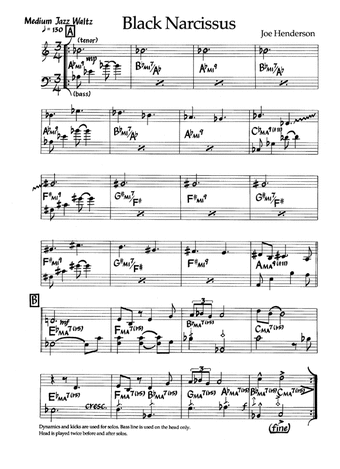
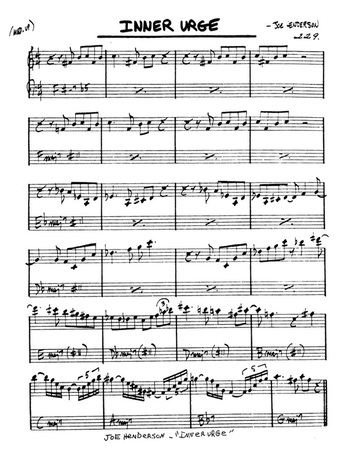
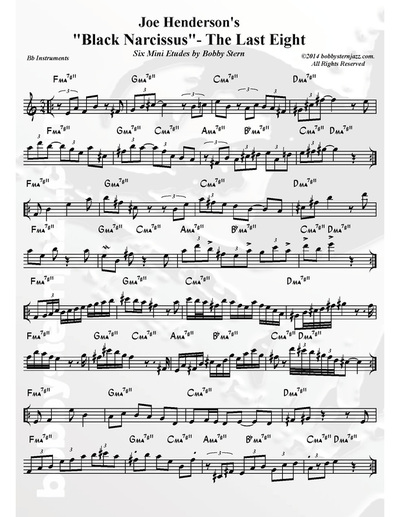
 RSS Feed
RSS Feed
